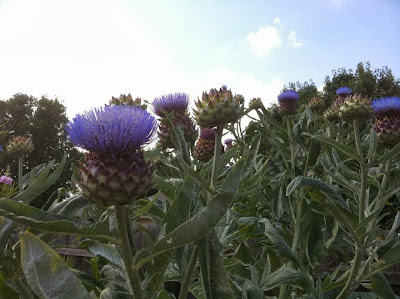Our first guest post of the season!
I am immensely grateful to Janet for giving me a great flower to think about in this season of frantic lab report grading and committee convening. The piece below first appeared in the Denton, Texas newspaper and the photograph on Janet's facebook page. Remember, you, too, can be a guest star on this blog.
 The Best in Show this year for the Denton County Fruit, Flower, Vegetable and Herb Show was the cardoon. I could make up anything at this point and you’d believe me as to what a cardoon is, since not many people are familiar with it. Even after looking at the specimen, the officials weren’t sure if it belonged with vegetables or flowers at the show. The cardoon is kind of an ornamental artichoke, which can be eaten when it is young. Since it is typically cultivated as an ornamental for its thistle-like flower, it was ultimately placed in the flower category in which it won Grand Champion in the youth division (grown by Emma and Lauren Martin).
The Best in Show this year for the Denton County Fruit, Flower, Vegetable and Herb Show was the cardoon. I could make up anything at this point and you’d believe me as to what a cardoon is, since not many people are familiar with it. Even after looking at the specimen, the officials weren’t sure if it belonged with vegetables or flowers at the show. The cardoon is kind of an ornamental artichoke, which can be eaten when it is young. Since it is typically cultivated as an ornamental for its thistle-like flower, it was ultimately placed in the flower category in which it won Grand Champion in the youth division (grown by Emma and Lauren Martin).
The cardoon in my backyard has been one of my favorite plants for a few years now. It is a perennial with large, silver foliage that grows most of the winter. It is a bit of a weird and wild plant, maybe even dangerous looking. I enjoy the drama of watching it grow larger all winter while nothing else is making much movement. It begins to spike in height late spring, often, it’s the tallest thing in my yard, just peeking over my six foot fence. And in June, I’m rewarded with flowers that are a gorgeous blue/purple (but very macho and tough!) After the blooms, the plant usually turns brown quickly and gets invaded by all kinds of insects. Chop it back and try not to dwell on it: people still have children and nobody’s a huge fan of changing diapers, right? The cardoon will come back from the roots later in the summer or fall and the performance begins anew.







-001.JPG)





